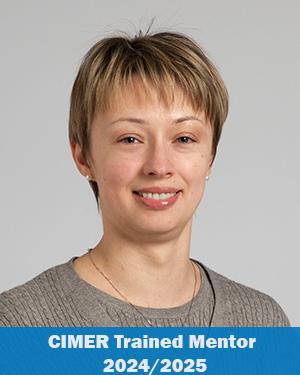Research News
07/29/2024
Basic research is fueling life-saving new advances in organ transplantation
Drs. Valujskikh, Dalton and McCurry’s research improves essential understanding and practices in transplantation and patient care.

Cleveland Clinic researchers work across disciplines to accelerate life-saving new technologies that address human organ transplantation’s most critical questions and challenges. Studies that focus on immunosuppression, organ viability and access inequities, among many others, to increase the number of available organs and improve treatment options for patients with end-stage organ failure.
Over 46,000 organ transplants were performed in the United States in 2023. The Cleveland Clinic, one of the top three organ transplantation centers in the country, performed 1,232 organ transplants in 2023 including heart, intestine, kidney, liver and pancreas, an increase of 17% from the previous year.
Meet three of the researchers who are asking big questions to improve transplant outcomes:
Anna Valujskikh, PhD – How the immune system responds to transplantation
Anna Valujskikh, staff in the Department of Inflammation & Immunity, studies immunologic memory, or how the immune system responds rapidly and more efficiently to previously encountered pathogens.
Dr. Valujskikh’s team focuses on the immunobiology of memory T cells in organ transplant recipients.
While absolutely necessary for host protection during infections and for efficient vaccination, memory T cells can harm life-saving organ transplants. Importantly, many non-transplanted individuals harbor memory T cells that can potentially recognize and respond to proteins from the donor organ. Such cells may arise during pregnancies, previous blood transfusions, or as a result of exposure to previous infections and environmental factors.
Regardless of their origin, the lab’s research has shown memory T cells express rapid and robust immune responses to a transplanted organ, leading to tissue injury and organ rejection. Furthermore, the data generated by the team demonstrates that memory T cells are resistant to the effects of currently used graft-prolonging therapies, and thus present a unique challenge in transplantation leading to poor transplant outcomes.
“Understanding the way the body is using memory T cells to protect itself from ‘foreign’ components of transplanted organs is essential for the development of therapeutics targeting pathogenic memory after transplantation while preserving the recipient’s ability to fight off opportunistic infections and malignancies,” Dr. Valujskikh says.
Jarrod Dalton, PhD – Closing the gap on healthcare disparities
Jarrod Dalton, associate staff and director, Center for Populations Health Research, leads research grounded in understanding health status, care and outcomes across diverse patient populations. Using data science and risk prediction modeling, the Dalton team is continuing to develop and refine the latest methods for evaluating and optimizing clinical treatment decisions across socioeconomic spectrums. The work is helping health systems, governments and organizations collaborate and strategize new ways to address clear disparities, including those of transplant patients.
As part of this work, Dr. Dalton and his team have developed a successful new model for prioritizing patients waiting for a lung transplant, improving outcomes and reducing deaths among those in need of donor lungs. The method offers a new way of thinking for developing allocation strategies to address a patient’s needs.
The Dalton team and members of Cleveland Clinic’s pulmonary department are collaborators in the National Heart, Lung and Blood Institute funded project to achieve equitable access to lung transplantation through advanced models of risk and outcomes and a driving force behind their research.
“As patients live longer with severe lung disease, their risk of developing complications and ultimately requiring a lung transplant increases,” Dr. Dalton says. “Clinicians see this every day, and our research is filling an important gap to help inform national policies for prioritizing patients in need of a lung transplant.”
Lung transplant allocation scoring models are implemented to ensure that the sickest patients who stand to benefit the most from a transplant procedure are prioritized, since there are not enough donors to meet the clinical demand nationally.
“The allocation scoring models are constantly being improved through research, including ours,” Dr. Dalton says. “We recognized a disconnect between how mortality risk, with and without a transplant, is interpreted in these models, and introduced a technique that better accounts for the additional risks that patients incur by accumulating time waiting for a donor.”
Kenneth McCurry, MD - Improving evaluation for transplant success
Kenneth McCurry, staff in the Department of Inflammation & Immunity, has performed more than two thousand lung transplants over his career. His lab investigates mechanisms that cause complications after lung transplant, conducting numerous studies that have led to an increase in donor organ viability and clinical innovations.
“Although more than 80 percent of lung transplant recipients survive for a year or more after their procedure, many can face severe complications,” Dr. McCurry says. “The goal of our research is to improve these outcomes for our patients by studying the risk factors that lead to post-transplant complications. By characterizing biomarkers indicative of complications, we can adjust our treatment plan to improve patients’ long-term prognosis.”
One study, published in The Annals of Thoracic Surgery, detailed how blood transfusion can cause detrimental effects to the pulmonary system and leads to higher morbidity and mortality in surgically and critically ill-patients post-transplant. The findings used data from over 20,000 adult lung transplants gathered from the United Network for Organ Sharing. The team’s research showed transfusions of more than ten units of blood (a unit is roughly one pint) was associated with increased 90-day mortality, even among the lowest-risk recipients. However, a transfusion of less than ten units showed no increase in mortality, even among the highest-risk recipients.
The team also has found that changes in lung weight affect transplant suitability through using ex vivo lung perfusion (EVLP), a technology that helps surgeons assess high-risk donor lungs and potentially repair them for transplantation. In a Journal of Surgical Research study, the researchers found three physiological indicators can be important predictors of transplant suitability in EVLP: lung weight at the donor hospital; lung weight at the end of EVLP; and lung weight change during EVLP.
One reason a lung may not be considered for transplantation and require EVLP is excess lung water and pulmonary edema sometimes called “wet lung” - a condition characterized by excess fluid accumulation in the lung sacs. Despite being a relatively common reason why donor lungs are considered unfit for transplant, there is currently no standard quantitative diagnostic tool to evaluate pulmonary edema in donor procurement. As a result, many lungs are declined for transplantation based on subjective characteristics.
Dr. McCurry and his team have found that lung weight is a good surrogate for assessing excess lung water, both at the donor hospital and during EVLP, and correlates with lung transplant outcomes. This has allowed much better assessment, allowing more lungs to be used for transplantation with confidence in a good outcome.
“Many patients with end stage lung disease are awaiting lung transplantation in the U.S. – hoping for a better quality of life and a longer life – with some dying prior to receiving a transplant,” Dr. McCurry says. “The focus of our work is to make more lungs available for them and to improve their outcomes after transplantation.”
Featured Experts
News Category
Related News
Research areas
Want To Support Ground-Breaking Research at Cleveland Clinic?
Discover how you can help Cleveland Clinic save lives and continue to lead the transformation of healthcare.
Give to Cleveland Clinic

